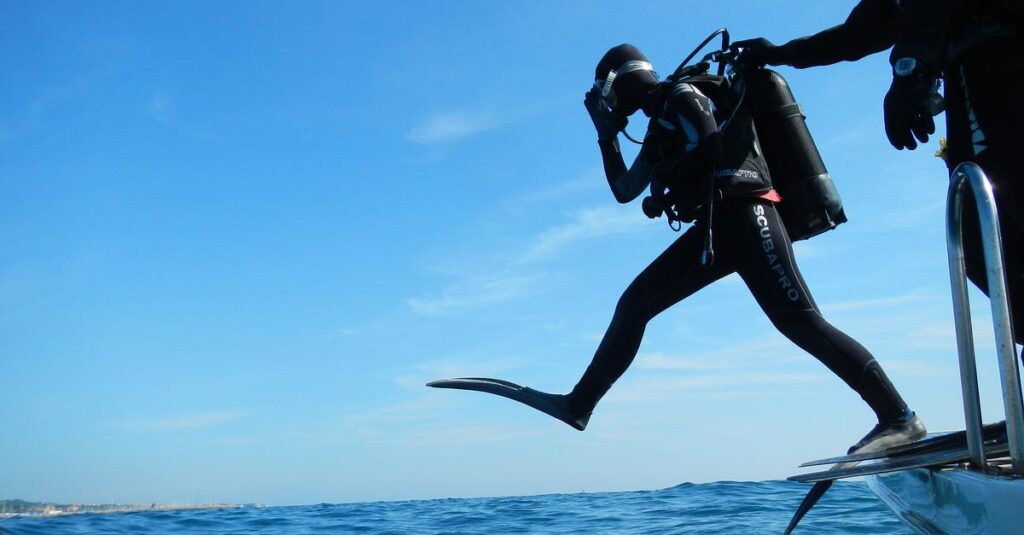

A jumpsuit wetsuit is a full coverage wetsuit option. While other jumpsuits may leave arms and legs bare or only cover half the body, the jumpsuit wetsuit covers everything from the neck to wrists and ankles.
While this may be your usual imagery when imagining a wetsuit, they’re not quite interchangeable. Keep reading to learn the difference, as well as other wetsuit styles and how to choose the one that’s best for you.
What Is the Difference Between a Wetsuit and a Jumpsuit?
In a scuba diving setting, a wetsuit refers to the general garment, while a jumpsuit is a specific style.
A wetsuit refers to the protective garment that you wear, usually while scuba diving. These suits are usually made of spongy neoprene, and the material contains many air bubbles that help trap your body heat.
Because the suit also allows a thin layer of water in between the suit and the person, these bubbles can warm the water and keep the wearer at a comfortable temperature for their dive.
Wetsuits are mostly waterproof, but the seals at the neck, wrist, and ankle seals are not. This is what allows water into the suit.
Jumpsuit wetsuits are the one piece wetsuits that you see. These cover the diver’s entire body, including:
- Torso
- Legs
- Arms
Jumpsuits usually zip up in the back for easy on and off, and they feature a slightly taller neck and collar. Some come with hoods, but most accommodate the hood easily.
Compared to other options, the jumpsuit is less accommodating to range of motion. Shortie wetsuits don’t cover the legs, and other options let you customize your coverage better.
Regardless, the jumpsuit wetsuit is still a popular choice, especially for those who want greater range in cooler water.
Other Types of Wetsuits
Other types of wetsuits include:
- Shortie: Covers the least amount (torso and part of arms and legs); provides environmental protection but little warmth
- Farmer(Long) John/Jane: sleeveless wetsuit hat cover legs and torso; usually worn under a long sleeve, keeping core warm and freeing the body to keep limbs warm
- Jackets: front zipper for easy on and off; provide additional warmth
- Vests: normally used in warm environments; protects against rashes and sun
Jumpsuit Vs Wetsuit – Which Is Better?
While the jumpsuit is a popular style, it’s not always the best choice. Check out these categories to see what comes out on top.
Comfort
As long as it’s warm enough, your shortie wetsuits are usually more comfortable than those that cover your limbs. They allow for greater motion and you don’t need to worry about covering more than you need.
If you’re diving in an area where you are more susceptible to nicks or burns, you may want something with greater coverage.
Warmth
The jumpsuit option is great for warmth. You’re not wearing too much, and your entire body is covered for proper insulation.
The Farmer John versions allow for more layering, and some may prefer them for regulating temperature in and out of the water alongside a diving jacket.
Protection
Full coverage options offer the most protection. The shortie swimsuits won’t do much to protect your limbs from environmental factors such as:
- Sun exposure
- Stings (i.e. jellyfish)
- Coral or rock scrapes
They’ll do nothing to protect you from the cold, either, so they’re not a great option when diving somewhere that has unpredictable temperatures.
Cost
Cost varies greatly between different brands and quality levels. You can assume that a shortie wetsuit costs less than a full-coverage option, but you’ll likely need to purchase additional equipment for protection.
You’ll need to pay attention to other details, such as thickness, to determine how valuable a suit is for your intended scuba diving.
References
https://scubaboard.com/community/threads/jumpsuit-vs-wetsuit.13629/
https://www.scuba.com/i/wetsuits
https://www.surfertoday.com/surfing/the-different-types-of-wetsuits
